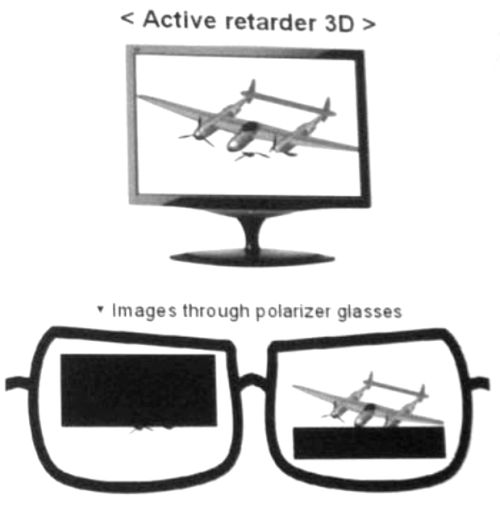|
|
This topic comprises 2 pages: 1 2
|
|
Author
|
Topic: Here we go: tons of 3D TV's and blu-ray players announced
|
Julio Roberto
Jedi Master Film Handler
Posts: 938
From: Madrid, Madrid, Spain
Registered: Oct 2008
|
 posted 01-06-2010 09:53 PM
posted 01-06-2010 09:53 PM



Just read the news to check out model announcements at CES from all the major manufacturers on 3D-enabled blu-ray players and TV's.
http://news.google.com/nwshp?hl=en&tab=wn&q=3d%20tv%20ces
It's the expected, but LG is investing in a twist of the time-sequential system by integrating a "large zscreen" in front of the TV screen.
The use of time-sequential 3D allows for full HD resolution per eye w/o much an increase in cost as the panel was already 480hz capable to begin with (BTW TI based projectors used in DCI top at 144hz there goes the home theater being superior in this parameter to a $100k DCI cinema projector...)
The downfall is the halving (or even less) of the light and the introduction of temporal disparities (which, at 480hz, we must admit must be unnoticeable to everyone).
But, and here comes the important refinement to the process: LG has engaged in a smart zscreen design which is line-sequential (instead of RealD's dumb full-frame one), which means that a LOT more light can go through and the temporal disparities are further reduced to a fraction of what little they already are.
I.e. the bottom part of one eye sees an image and SIMULTANEOUSLY the other eye is seeing the top part of the other frame. No need for any eye to go completely black at any time (ideally). No full-frame blanking interval waiting for the active glasses to go from full-transparent to darker-darker-darker-full black.

In a traditional implementation, like Sony's or Panasonic, one of the eyes would be seeing full black (=no light, =less brightness). Also, since they use active glasses, they also need an additional blanking interval to allow for the syncronization and switching (can't do all that fast running on batteries from the glasses).
It's more expensive to implement than a full passive retarder filter, which costs mere cents to manufacture against a line-addresable active zscreen, which can cost between $100 and $300 depending on the size, but a passive filter needs a doubling in resolution anyway, so the cost is offset.
It looks like LG may have found the perfect balance between cost and performance. And using passive glasses to boot. I wonder how it does ghosting wise, as the approach could backfire in that department, depending on how fast the LC elements can really switch (in spite of marketing claims of 480 and 600hz). I guess we'll soon find out.
Most of the stuff is coming in the third quarter of 2010. 3D fans, get your wallets ready. They are planning to charge a premium to the early adopters. It's being figured around $4000 for a 55" 3D TV and 3D blu-ray player companion. This will come down to the high $2K's in a additional year or two.
| IP: Logged
|
|
|
|
|
|
|
|
|
|
|
|
|
|
Sam Graham
AKA: "The Evil Sam Graham". Wackiness ensues.

Posts: 1431
From: Waukee, IA
Registered: Dec 2004
|
 posted 01-07-2010 12:53 PM
posted 01-07-2010 12:53 PM





Here's a decent summary story from some Canadian publication:
quote: marketnews
As CES officially opens, it's already clear that 3D will be one of the big themes of the show. And given the success that James Cameron's 3D blockbuster Avatar had at the box office over the holidays, consumers are pretty excited about 3D. Speaking at Panasonic's 2010 CES Press Conference on January 5, Avatar Producer Jon Landau said, "3D is not about gags; it's about creating a window into a world. I think we'll see 3D become ubiquitous."
As reported previously on this site and in Marketnews and Here's How magazines, the 3D TV systems arriving this year will employ active liquid-crystal glasses. When displaying 3D content, 3D HDTVs show alternating left-and right-eye frames. The lenses on the glasses are controlled by a transmitter on the TV, opening and shutting rapidly so that each eye sees only the image intended for it. The eye-brain integrates these images into a complete 3D picture. Panasonic demonstrated its version of this system at CES and during roadshows held in 2009; and I found it very effective.
In late 2009, the Blu-ray Disc Association ratified a standard for 3D Blu-ray, paving the way for 3D Blu-ray players and software.
At CES 2010, several manufacturers announced plans to ship 3D HDTVs, Blu-ray players and home-theatre systems in the first half. Some TVs will be fully 3D-capable, and will be supplied with 3D glasses. Others will be 3D-ready, capable of driving an optional 3D transmitter for controlling the glasses.
The next version of Panasonic's V-series Viera plasmas will feature 3D. They'll be available in 50", 54", 58" and 65" screen sizes, along with a 3D Blu-ray player. This summer, Sony will ship a 60" 3D LED-edgelit LCD, complete with two pairs of 3D glasses, as well as a 3D-ready 52" LED-backlit model and a Blu-ray 3D player.
At its press conference, Samsung said one-third of the models in its lineup of LED-illuminated LCD televisions for 2010 will feature 3D, including the pencil-thin 9000 series. Samsung will also offer 3D CCFL-illuminated LCDs, plasmas, Blu-ray players and home-theatre systems. The televisions will have 3D processor that can create a 3D effect with 2D content, Samsung said.
Toshiba's forthcoming CELL TVs will feature 3D. The term "CELL TV" refers to the televisions' eight-core video processor, which the company says is 143 times more powerful than the processors in competing televisions. The CELL processor's functions include the creation of 3D effects from 2D content. There will be five models in two series, with 46", 55" and 65" screen sizes, all of them LED-backlit LCDs with 512-zone local dimming.
LG's ultra-thin Infinia LE9500 47" and 55" LED-backlit TVs will be 3D-ready. The company will offer a 3D Blu-ray player later in 2010.
What to watch in 3D: Also at CES, manufacturers announced partnerships to drive the volume of 3D content. Jeffrey Katzenberg, CEO of DreamWorks Animation, and Frederic Rose, President and CEO of Technicolor, visited the Samsung Press Conference to officially present the first 3D Blu-ray release to Samsung: 2009's Monsters vs. Aliens. DreamWorks decided in 2007 to make all future releases in 3D, Katzenberg noted. "3D is a wonderful way to reduce piracy, and it provides a premium experience for moviegoers," he stated. Of the top-10 performing movies in 2009, four were 3D titles, he observed.
Panasonic announced a partnership with the U.S. satellite-TV service DirecTV to create three dedicated 3D channels, with content ranging from movies to sports to documentaries. A firmware update will allow DirecTV satellite receivers to display these 3D channels, which will launch in June.
Sony announced an agreement with Discovery Communications and IMAX Corporation to develop a 3D TV network that will launch in 2011. "We view 3D as the future of television," stated Discovery President and CEO David Zaslav at Sony's CES 2010 Press Conference." The channel will feature documentary and children's programming from Discovery, IMAX, Sony Pictures Entertainment and other providers. Sony is also a sponsor of ESPN's 3D sports venture, and is providing 3D cameras for this summer's FIFA World Cup of Soccer.
| IP: Logged
|
|
|
|
|
|
|
|
|
|
|
|
|
|
|
|
|
|
All times are Central (GMT -6:00)
|
This topic comprises 2 pages: 1 2
|
Powered by Infopop Corporation
UBB.classicTM
6.3.1.2
The Film-Tech Forums are designed for various members related to the cinema industry to express their opinions, viewpoints and testimonials on various products, services and events based upon speculation, personal knowledge and factual information through use, therefore all views represented here allow no liability upon the publishers of this web site and the owners of said views assume no liability for any ill will resulting from these postings. The posts made here are for educational as well as entertainment purposes and as such anyone viewing this portion of the website must accept these views as statements of the author of that opinion
and agrees to release the authors from any and all liability.
|

 Home
Home
 Products
Products
 Store
Store
 Forum
Forum
 Warehouse
Warehouse
 Contact Us
Contact Us




 Printer-friendly view of this topic
Printer-friendly view of this topic






![[beer]](graemlins/beer.gif)





![[Wink]](wink.gif)
![[Big Grin]](biggrin.gif)






